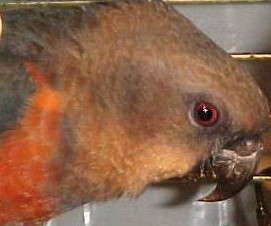Home made, quilted pet carrier covers
Hand raised and tame baby Parrots

|
The Parrots of Africa Poicephalus The 9-inch-long Senegal parrot (Potcephalus senegalus) is probably the most readily available of the genus Poicephalus, and it is instantly recognizable with its charcoal-gray head, black beak and yellow-to-orange chest marked with a distinctive green V. The olive-green wings sport yellow “epaulets” at the bend. Adult eyes are yellow-gold; baby Senegals have gray eyes. This compact parrot is possibly as perfect an apartment pet as one could desire. Young, hand-raised Senegals develop sweet, friendly dispositions and bond closely with their owners. They are capable of amusing themselves inside their cages for extended periods of time, and most will adapt well to a career person’s schedule. They can be somewhat shy, so they should be handled and socialized regularly. These birds are not loud, but their whistles can sound shrill to some ears. They can become fair talkers, especially when words or phrases are repeated over and over to them while they are still young. A Senegal parrot can make a great first bird for someone who wishes to start with a small bird that really acts like a large parrot. Senegals seem happiest in roomy cages and enjoy flitting about between two swings installed inside. Mornings incite an almost involuntary display of whistling, chirping, climbing and leaping about the cage. Like their larger psittacine cousins, Senegal parrots use their feet to play and eat. They are especially fond of small, foot-held wooden playthings, and enjoy gnawing on larger (Amazon sized) hanging wood toys. Short lengths of millet are relished as treats, as are chunks of corn on the cob and peanuts, which the birds often eat by making a small opening in one end of the shell and methodically removing the nuts inside. A pair of Senegals will usually be quite affectionate toward one another, engaging in “kissing” and mutual preening year-round. While there has been some dissension as to whether or not the sex of Senegals can be determined visually, the males usually have gold vents and undertail coverts while the females have green ones. Their plumage seems to become brighter and more intense as mating season (September to November in the wild, autumn into spring in captivity; some breed year-round) approaches. The birds appreciate some privacy for breeding, and many prefer the security of a cage to an aviary. If your Senegal or other small Poicephalus parrot is shy and skittish when someone other than yourself must service its cage, advise the person to avoid making eye contact with the bird. The bird will probably remain standoffish, but panic will usually be alleviated. Senegals are native to central-west Africa where they are common in open forests and savannah woodlands. There is some seasonal migration as the birds travel toward food sources. Their natural environment is so harsh that they have evolved into hardy, adaptable creatures. The Meyer’s parrot (P. meyeri) is a mostly brown bird distinguished by a bright-yellow patch or band on the head, green-to-turquoise on the rump and belly, and yellow legs, underwing coverts and patches at the bend of the wing. The eyes are orange-red in adults and dark brown in immature birds. Meyer’s parrots are generally slightly smaller than Senegals, but the difference may be so slight as to be nearly imperceptible. The Meyer’s parrot is not as readily available as the Senegal, since fewer were imported during the 1970s and ‘80s. Its personality is similar, although it may be more shy than the Senegal. The care requirements are basically the same, and a hand-reared Meyer’s can make a delightful pet. The Meyer’s inhabits a wide range in central and eastern Africa, and makes its home in savannah woodlands, acacia scrubland or near farmland. The common denominator is water; it is seldom found far from a source of water. The Meyer’s parrot prefers to roost in tall trees, yet its flight patterns are relatively close to the ground. The wild diet includes seed, berries, nuts, and corn and grain foraged from farmland. The same genus as Senegal and Meyer’s parrots, the red-bellied (P rufiventris) and brown-headed (P. cryptoxanthus) parrots can make excellent pets when hand-raised. The 9- to 11-inch long Jardine’s parrot (P. gulielmi) is a dark green bird with orange-red markings on the forehead, thighs and edge of the wings. The orange coloration may not be apparent in a very young bird, but will develop as it matures. The Jardine’s parrot is also distinguished by a black-tipped, horn-colored beak that is quite large in proportion to its head. There are several subspecies; the P. g. fantiensis, also referred to as the lesser Jardine’s, is the one most readily available in the U.S. The Jardine’s is relatively quiet, making it a good candidate for an apartment or condo bird. It can become a good talker, and is a talented whistler and “sound effects” bird. The Jardine’s is quite playful, and, like the Senegal parrot, is fond of swings. Provide it with a large cage to accommodate its wingspan, which is somewhat large in proportion to the body. Jardine’s parrots are enthusiastic bathers and should be misted frequently or provided with a large, shallow dish of water for a morning bath. In the wild, the Jardine’s is a forest-dwelling bird indigenous to central Africa where it subsists on seeds, nuts, berries and fruit. This species is not always readily available in the pet trade, but as domestic breeding efforts continue to flourish, availability may increase. The Jardine’s can be a fine pet for a novice bird owner who has done some research to familiarize himself or herself with the species. |
Progression of Babies Growth
 |
 |
 |
| 1 Day Old | 3 Days Old | 9 Days Old |
 |
 |
 |
| 21 Days Old | 31 Days Old | 40 Days Old |